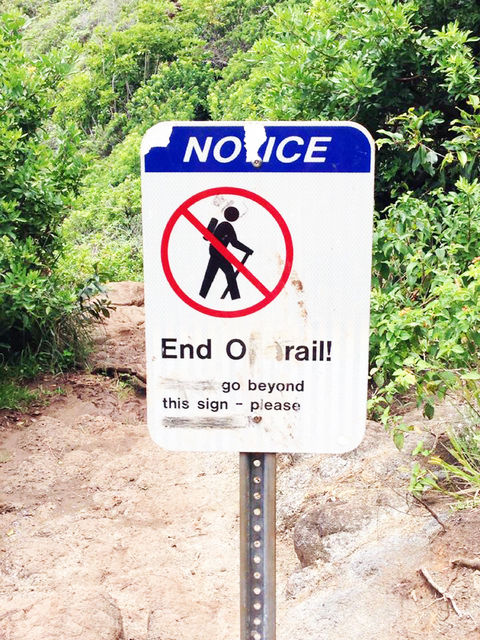LIHUE — A Kauai County councilmember is proposing a measure that would require hikers in need of rescue — who disregard warnings — to pay the county for recovery missions. Bill 2589, introduced by Kauai County Councilman Mason Chock, would
LIHUE — A Kauai County councilmember is proposing a measure that would require hikers in need of rescue — who disregard warnings — to pay the county for recovery missions.
Bill 2589, introduced by Kauai County Councilman Mason Chock, would allow government agencies engaged in search-and-rescue operations to seek reimbursement from “individual or individuals with intentional disregard for safety, such as disregarding a warning or notice.”
“When you call the ambulance, you gotta pay for services,” he said. “Should the taxpayers pay for people’s taxi services? Part of it is their responsibility to take. Right now, basically, anybody can call for taxi service and we gotta pay for it.”
Chock said, however, persons who have accidents on trails, for example, do not need to reimburse the county after seeking help.
“This is not what the bill covers; it only allows for the question of negligence to be considered,” he said. “We don’t want people to stop calling for help. If people want help, they’re gonna call for help. But what I’m encouraging is people to think about what it is they’re doing before they do it.”
Chock said the county’s main concern in regard to search and rescue is on the Na Pali Coast.
“Basically, our biggest rescue situation on our island is on the Na Pali Coast,” he said. “I was a fireman for 12 years. We get people walking bare feet to Kalalau without any water, with a three-year-old, sometimes an infant. We get people who are walking on braces, have new hips. They don’t realize how treacherous the hike is.”
Sarah Blane, county spokeswoman, said in fiscal year 2014-15 the county spent almost $20,000 on helicopter rescues.
“In FY14-15, there was a total of 43 hours of rescues using the helicopter at $450 per flight hour,” she said in an email.
This figure does not include personnel costs, she said.
Councilwoman JoAnn Yukimura said she agrees with the measure’s concept, but would like to study the logistics of the bill.
“I’ve raised the issue several times on floor, and I’m glad that Councilmember Chock is trying to find a practical way … to recover costs,” she said.
A public hearing for the bill is scheduled for July 1.
Jeffrey Courson, a resident hiker on Kauai for the past 38 years, supports the measure.
“It always seems super crazy to me that people don’t have to pay for their own mistakes,” he said. “That’s ridiculous. It’s a cause-and-effect world. If you’re not willing to do your research, and you decide to fly off a cliff, why should the general public pay for that?”
Courson said individuals going on trails should be aware of the dangers.
“It’s pretty much any way you try to increase awareness, usually the people who get in trouble aren’t readers,” he said. “They don’t take time to study.”
Chock said proving negligence will be difficult.
“That means you’re gonna have to have documentation that there was a sign,” he said. “The person disregarded the sign because they can say they didn’t see it. If and when we know there was a real blatant disregard, maybe thrill seekers who know that you cannot do certain things here and do it anyways, then those things will come into question.”
Chock said discussion arose after 121 hikers were rescued from Hanakapiai on the Na Pali Coast in April 2014 after rising waters made the path back to safety impossible. The rescue cost the county about $3,560.68 for firefighter overtime pay and fuel costs.
“What (the rescue last year) brought up was a discussion of the amount of people that are traveling to Hanakapiai or on the Kalalau Trail on a daily basis,” he said.
As far as the rescue last year involving the stranded hikers, there was “no telling if there was intentional disregard for safety,” he said. “I don’t think so.”
Chock said an independent study determined that upwards of 2,000 people hike along Hanakapiai or on the Kalalau Trail on a daily basis.
“The studies that came back were, on the low end, up to 500 a day, and, on the high end, up to 2,000 a day,” he said. “It’s closer to the 2,000 side because it’s a little bit dated. That along with the budget of the county is very tight we have to look at where our expenses going and quite frankly most of the responses to recues fall under multi jurisdiction or state’s jurisdiction.”
Chock said the language for the measure will “have to be more specific” in the future.
“I looked at HRS (Hawaii Revised Statutes), the state’s rules and within their ordinance it has specific language,” he said. “What I’m doing is taking our language that we have making it consistent with their language. What I’m changing is a statement of gross negligence to what the state says, which is intentional disregard for safety.”


